Week 8: Nanotechnology and Art
I really enjoyed
being introduced to nanotechnology this week, as I had not understood much
about how it permeates our everyday life in so many ways. I had this mental
image of scientists in a lab looking at atoms, very separate from anything I
would need to use. However, I had no idea that the leggings I wear every day
contain silver nanoparticles to make them microbial (Gimzewski).
It is important
for people to learn about nanotechnology because many do not realize how it
impacts us. For example, using nanotechnology to make different kinds of
pesticides or “health” supplements impacts us on a very personal level because
it could influence the choices we make about how we fuel our bodies (Gimzewski).
With new “health” fads being so influential these days, it is important that we
have enough information to make a conscious decision about whether or not
something we eat is healthy.
Art has such a
large role to play in this space because it can help people who are not nano-scientists
to learn about this subject and how it plays a role in our lives. Art exhibits
like “nano” at the Los Angeles County Museum of Art can help people understand
how these particles work using their senses, which cannot be done in everyday
life (Lovgren). This is a useful method because it is more accessible to people
than a nanotechnology class would be, and it is a presented in a more fun and
engaging way as well.
Once the
fundamentals of nanotechnology are understood, it is also possible to see just
how beautifully nature arranges itself on such a tiny scale. Snowflakes are an
excellent example of self-arrangement that have so much beauty (Gimzewski).
Each snowflake is so different in shape and structure, yet the properties of
each snowflake as a whole are so similar. Many scientists-turned-artists have
found other substances that contain similar beauty. Christian Orfescu is a
materials scientist by day, and abstract artist by night, using his work with
nanoparticles to create what he calls “nanoart,” inspired by various molecular
landscapes (Feder). He hopes that his work will inspire curiosity about
nanotechnology in others.
 |
| Cris Orfescu's "nano art" |
Works
Cited
Bentley ,
W.A., and W.J. Humphreys. “Snow Crystals.” Children's Books & More,
passion2read.wordpress.com/tag/snowflake-bentley/https://passion2read.wordpress.com/tag/snowflake-bentley/.
Feder, Barnaby
J. “The Art of Nanotech.” The New York Times, The New York Times, 25
Jan. 2008, bits.blogs.nytimes.com/2008/01/25/the-art-of-nanotech/.
Gimzewski ,
Jim, director. Nanotech Jim pt6. 21 May 2012,
youtu.be/oKlViSKkPd0?list=PL9DBF43664EAC8BC7.
Gimzewski,
Jim, director. Nanotech Jim pt3. 21 May 2012, youtu.be/X0HCNiU_108.
Gimzewski,
Jim, director. Nanotech Jim pt5. 21 May 2012, youtu.be/4OWc8nmHJmY.
Gutsche,
Jeremy. “‘Self Cleaning’ Sportswear.” Trendhunter, 12 Jan. 2007,
www.trendhunter.com/trends/self-cleaning-sportswear.
Lovgren,
Stefan. “Can Art Make Nanotechnology Easier to Understand?” National
Geographic, National Geographic Society, 23 Dec. 2003,
news.nationalgeographic.com/news/2003/12/1223_031223_nanotechnology.html.
Orfescu, Cris.
“Nanoart.” Cris Orfescu,
crisorfescu.com/product-category/nanoart-prints-gallery/.



Comments
Post a Comment